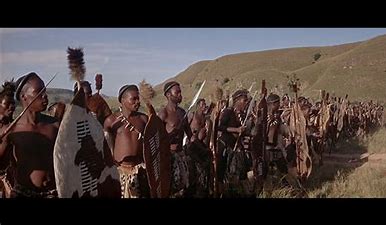“Zulu” appeared on the big screen in Cinemascope in 1964, almost 60 years ago. I saw it then, so I can attest to the grandeur of the film on a giant screen. If you have a large screen-TV and subscribe to Netflix and others you can still get the full-room effect now.
Most of you have never seen it. The music was composed by John Barry, who also did the first James Bond films, and was known for his “African”-themed music. “Out of Africa” captured the grander scope of Africa from the cockpit of a World War I bi-plane. And like “Out of Africa”, “Zulu” was based on a true story, about the aftermath of the Battle of Islandlwana at the start of the Anglo-Zulu War in 1879.
At Islandlwana 20,000 Zulus with spears and assegais (shields) met and killed about 1300 English troops in a stunning defeat, and the film takes up just after that battle, when 4000 of the Zulus spun off to attack a mission- hospital station at Rorkes Drift about 40 miles away. It was defended by 150 men.
This is a true story, in which those Englishmen successfully defended the station, killing hundreds of Zulus in multiple attacks, and which the Zulus, being a warrior society, finally broke off with a salute to the bravery of the men who defended that watering hole.
Pretty classy.
Many people who have never seen the entire film still have seen the final battle scene, also below, but few have seen this magnificent opening scene of the film, about 7 minutes, that featured a marriage dance between dozens of Zulu maidens with young warriors about to go into war against the English. It was done at the Zulu King Cetshwayo’s royal Kraal, or compound. National Geographic could only capture such scenes in still-life photos, and for many years in black and white.
Anthropologists said at the time that these 7 minutes were “museum perfect”. So I couldn’t help but wonder if the Critical Race Theory crowd, who weren’t even born when this film was made would agree? No one had even heard of Martha and the Vandellas or the Temptations in 1964, except maybe in Motown, nor had anyone outside of Soweto ever heard of Mahlathini, the Mahatello Queens, or Mbaqanga, the music most of these young dancers would have been very familiar with in 1964. (Look these singers and music up, the music can be narcotic.)
The Indestructible Beat of Soweto




